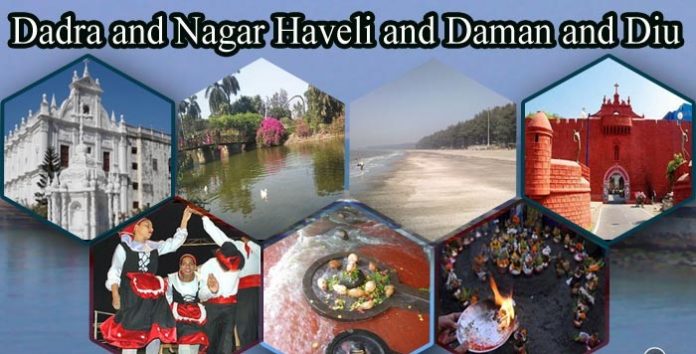Currently we are up with another astonishing union territory, Dadra and Nagar Haveli and Daman and Diu. Dadra and Nagar Haveli and Daman and Diu, (DNHDD), is one of seven union territories in India. In our discourse, we will be discussing about cultural, geographical, political, historical and economical features of the union territory.
What are the cultural aspects of Dadar and Nagar Haveli and Daman and Diu? What is the literary rate of Dadar and Nagar Haveli and Daman and Diu?
Dadra and Nagar Haveli and Daman and Diu is a union territory in western India. It was fabricated through the fusion of the former union territories of Dadra and Nagar Haveli and Daman and Diu.This region is majorly influenced by Gujarat. So for deep knowledge about Dadra and Nagar Haveli and Daman and Diu first go and read our Gujarat blogs. Links are mentioned below:
Know Gujarat- 1: https://www.hranker.com/blog-detail/138
Know Gujarat- 2: https://www.hranker.com/blog-detail/141
Let’s explore further and study about the culture of the territory.
Table of Contents
CULTURE:
Dadra and Nagar Haveli and Daman and Diu have a heterogeneous culture. As the area is near Gujarat hence Gujarat cuisine, costumes, language etc. is convinced by this union territory.
- Most of the people of this union territory have their mother tongue as Gujarati. Along with Gujarati, Hindi and English are also the official languages.
- Most of the people in this region belong to different tribes. Kokna, Warli, Koli, Dhodia, Kathodi, Siddi, Naika and Dublas are the most important tribes.
- The costume of Daman and Diu is influenced by Gujurati costumes as well as Portuguese culture. Women wear Ghaghra with blouse and odhani. Men wear dhoti or pajama with kurta or shirt.
- Some of famous dishes are Chokha, with saag and curry, Puri, lapsee, dudh-plag, Chicken bullet, Fish Koliwada, Cozido, Val nascido, Crabs and lobsters are well eaten.
- Some of the major festivals of the area are Makar shankranti, Holi, Janmashtami, Rakshan bandhan, Diwali, Id, Christmas, New Year, Garba Dance Festival, Gangaji Fair, Nariyal Poornima, Parsi New year etc.
- Main dance form which are popular in this region are namely Tarpa Dance, Bhawada Dance, Tur and Thali Dance, Verdigao Dance, Vera Dance, Gheria Dance, Dhol Dance, and Portuguese dances etc.
- The most popular crafts are making leather slippers and weaving mats and baskets of bamboo.
Now let’s talk about geography of Dadra and Nagar haveli and Daman and Diu.
GEOGRAPHY:
Dadra and Nagar Haveli and Daman and Diu are a union territory in western India and were created by merging the two original union territory Dadra and Nagar Haveli and Daman and Diu.
Total Area: 491 sq. km
Total population: 343,709
Latitude extension: 20.3229° N
Longitude extension: 72.9667° E
- Dadra is a small enclave within the state of Gujarat.
- Nagar Haveli is a C shaped enclave located between the states of Gujarat and Maharashtra which contains a counter enclave of Gujarat around the village of Maghval.
- Daman is an enclave on the coast of Gujarat and Diu is an island off the coast of Gujarat.
- Daman and Diu is situated bordering Gujarat and the Arabian Sea while Dadra and Nagar Haveli share borders with Gujarat and Maharashtra.
- Tree cover has been estimated around 27 sq. km, which is around 5.5% of the total geographical area of DNH (Dadra and Nagar Haveli).
- The Dadra and Nagar Haveli Wildlife Sanctuary cover 91.39 sq. km i.e. about 19% of the union territory’s total area.
- The recorded forest area of Daman and Diu is 6.4 sq. km, which is 5.72% of which 1.23 sq. km lies in Daman and 5.17 sq. km in Diu.
- Daman and Diu have only one Wildlife Sanctuary, which covers 1.96% of geographical area of the Union Territory.
- The Daman Ganga, also known as Dawan River, flows through the Union Territory of Dadra and Nagar Haveli and Daman and Diu.
- The Union Territory is having clay- loam type of soil, which is poor in drainage.
Climate:
The Union Territory has tropical monsoon climate with hot summers and pleasant winters. The summers are hot and more humid. The average summer temperature in Dadra and Nagar Haveli and Daman and Diu remains 35 °C while in winter the temperature dips to 18 °C. Dadra & Nagar Haveli receives an annual rainfall of around 2,000 mm to 3,000 mm, while Daman and Diu experience an annual rainfall of about 1,687 mm.
Now let’s talk about Political aspects of the Union territory.
GOVERNMENT AND POLITICS:
The President of India appoints an administrator to administer the territory on behalf of the central Government of India. The central government may appoint advisers to assist the administrators with their duties. The union territory is made up of three districts: Daman district, Diu district, Dadra and Nagar Haveli district. Law enforcement within the territory is the responsibility of the Dadra and Nagar Haveli and Daman and Diu Police. The territory falls under the jurisdiction of the Bombay High Court.
Representation of Dadra and Nagar Haveli and Daman and Diu in Parliament:
- Lok sabha: 2
- Administrator: Praful Khoda Patel
- High court: Bombay High court
Let’s study about the history of Dadra and Nagar Haveli and Daman and Diu.
HISTORY:
The union territory was created by the merger of the former union territories of Dadra and Nagar Haveli and Daman and Diu. The territory is made up of four separate geographical entities Dadra, Nagar Haveli, Daman and the island of Diu.
- Daman and Diu were under Portuguese rule from the 1500 until they were taken over by India on 19 December 1961.
- Dadra and Nagar Haveli was under Portugueseauthorities in 1818 until they were captured by pro-India forces in 1954 and were formally seized to India on 11 August 1961.
- Daman and Diu were administered as part of the union territory of Goa from 1962 till 1987 until it becomes a separate union territory.
- Dadra and Nagar Haveli was administered as Free Dadra and Nagar Haveli, before becoming a union territory in 1961.
- The Plans for the proposed merger were announced by the Government of India in July 2019.
- The Government of India proposed merging the two territories into a single union territory because to reduce duplication of services and reduce the cost of administration.
- Both of them (Daman and Diu and Dadra and Nagar Haveli) were two separate neighbouring Union Territories which merged in January 2020.
It’s time to have a discussion about economic contribution of the Union territory.
ECONOMY:
The economy of Dadra Nagar Haveli and Daman Diu revolves around the agriculture sector. About 60% of the population of this Union Territory depends upon agriculture as their source of income. Other than the agricultural sector, Dadra Nagar Haveli and Daman Diu have multiple manufacturing industries. The five major activities of the Union territory that influence economy are agriculture, industries, forestry, animal husbandry and tourism.
Here are interesting facts about Dadra Nagar Haveli and Daman Diu:
- The Union Territory has several tourist attractions such as Cathedral of Bom Jesus, Diu Fort, Jampore Beach, Jetty Garden, Somnath Mahadev Temple, etc.
- Literacy Rate in Dadra and Nagar Haveli as per 2011 Census Data is about 77.65% and Literacy Rate in Daman and Diu as per 2011 Census Data is about 87.07% which is above Indian literacy rate.
- Sex Ratio in Dadra and Nagar Haveli as per 2011 Census Data is 774 females per 1000 males on the other hand Sex Ratio in Daman and Diu as per 2011 Census Data is 618 females per 1000 males.
- To boost tourism in the merged Union territory, Daman & Diu and Dadra & Nagar Haveli, a new tourism logo was launched with a tagline “Small is Big”.
Therefore, this was all the chief necessitate information about Dadra Nagar Haveli and Daman and Diu that will helps in your preparation for competitive exams like SSC CGL, CDS, Civil Services and NDA etc.
In the next blog, we would be discussing some interesting facts and trivia about the Union Territory of Delhi. Click here for Know your State – ‘Delhi’.
If you wish to read about the other Island States of India, you can click on the links given below:
Know your State ‘Andaman and Nicobar Islands’
Know your State ‘Lakshadweep’
THANK YOU




